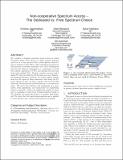| dc.contributor.author | Jagannathan, Krishna Prasanna | |
| dc.contributor.author | Menache, Ishai | |
| dc.contributor.author | Zussman, Gil | |
| dc.contributor.author | Modiano, Eytan H. | |
| dc.date.accessioned | 2013-10-21T17:25:47Z | |
| dc.date.available | 2013-10-21T17:25:47Z | |
| dc.date.issued | 2012-12 | |
| dc.date.submitted | 2012-06 | |
| dc.identifier.issn | 0733-8716 | |
| dc.identifier.uri | http://hdl.handle.net/1721.1/81460 | |
| dc.description.abstract | We consider a dynamic spectrum access system in which Secondary Users (SUs) choose to either acquire dedicated spectrum or to use spectrum-holes (white spaces) which belong to Primary Users (PUs). The trade-off incorporated in this decision is between immediate yet costly transmission and free but delayed transmission (a consequence of both the possible appearance of PUs and sharing the spectrum holes with multiple SUs). We first consider a system with a single PU band, in which the SU decisions are fixed. Employing queueing-theoretic methods, we obtain explicit expressions for the expected delays associated with using the PU band. Based on that, we then consider self-interested SUs and study the interaction between them as a non-cooperative game. We prove the existence and uniqueness of a symmetric Nash equilibrium, and characterize the equilibrium behavior explicitly. Using our equilibrium results, we show how to maximize revenue from renting dedicated bands to SUs and briefly discuss the extension of our model to multiple PUs. Finally, since spectrum sensing can be resource-consuming, we characterize the gains provided by this capability. | en_US |
| dc.description.sponsorship | National Science Foundation (U.S.) (Grant CNS-0915988) | en_US |
| dc.description.sponsorship | National Science Foundation (U.S.) (Grant CNS-0916263) | en_US |
| dc.description.sponsorship | National Science Foundation (U.S.) (Grant CNS-1054856) | en_US |
| dc.description.sponsorship | National Science Foundation (U.S.). Engineering Research Centers Program (Center for Integrated Access Networks Grant EEC-0812072) | en_US |
| dc.description.sponsorship | United States. Office of Naval Research (Grant N00014-12-1-0064) | en_US |
| dc.description.sponsorship | United States. Army Research Office. Multidisciplinary University Research Initiative (Grant W911NF-08-1-0238) | en_US |
| dc.language.iso | en_US | |
| dc.publisher | Institute of Electrical and Electronics Engineers (IEEE) | en_US |
| dc.relation.isversionof | http://dx.doi.org/10.1109/JSAC.2012.121217 | en_US |
| dc.rights | Creative Commons Attribution-Noncommercial-Share Alike 3.0 | en_US |
| dc.rights.uri | http://creativecommons.org/licenses/by-nc-sa/3.0/ | en_US |
| dc.source | Other University Web Domain | en_US |
| dc.title | Non-Cooperative Spectrum Access -- The Dedicated vs. Free Spectrum Choice | en_US |
| dc.type | Article | en_US |
| dc.identifier.citation | Jagannathan, Krishna, Ishai Menache, Eytan Modiano, and Gil Zussman. “Non-Cooperative Spectrum Access -- The Dedicated vs. Free Spectrum Choice.” IEEE Journal on Selected Areas in Communications 30, no. 11 (December 2012): 2251-2261. | en_US |
| dc.contributor.department | Massachusetts Institute of Technology. Department of Aeronautics and Astronautics | en_US |
| dc.contributor.department | Massachusetts Institute of Technology. Department of Electrical Engineering and Computer Science | |
| dc.contributor.mitauthor | Modiano, Eytan H. | en_US |
| dc.contributor.mitauthor | Jagannathan, Krishna Prasanna | |
| dc.relation.journal | IEEE Journal on Selected Areas in Communications | en_US |
| dc.eprint.version | Author's final manuscript | en_US |
| dc.type.uri | http://purl.org/eprint/type/JournalArticle | en_US |
| eprint.status | http://purl.org/eprint/status/PeerReviewed | en_US |
| dspace.orderedauthors | Jagannathan, Krishna; Menache, Ishai; Modiano, Eytan; Zussman, Gil | en_US |
| dc.identifier.orcid | https://orcid.org/0000-0001-8238-8130 | |
| mit.license | OPEN_ACCESS_POLICY | en_US |
| mit.metadata.status | Complete | |
